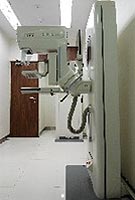|
|
|
|
|
| Health
Check-up Plan | Individual Diagnostic Test | FAQs| |
|
|
| |
Mammography
 Mammography
is important because in its earliest stages breast
cancer may not be palpable; it may be too small to
feel as a lump or tissue change. Mammography can help
detect these changes two years or more before you
would feel them. Physical examination is also important
because premenopausal breast tissue is often dense
and fibrous, which may decrease the reliability of
mammography for young women. Mammography
is important because in its earliest stages breast
cancer may not be palpable; it may be too small to
feel as a lump or tissue change. Mammography can help
detect these changes two years or more before you
would feel them. Physical examination is also important
because premenopausal breast tissue is often dense
and fibrous, which may decrease the reliability of
mammography for young women.
If you notice any change in your
breast (such as a lump or other texture change, breast
pain, skin dimpling, or nipple discharge), see your
doctor. Mammography or other diagnostic tests may
be recommended to evaluate the changes taking place.
The majority of these changes are due to benign-that
is, no cancerous--conditions, but you'll be glad you
checked.
If a lump is detected after the
mammography is done, it may be essential to take a
biopsy for the final diagnosis.
Highlights:
- OPDOSE optimizes X-ray dose and image quality..
- OPCOMP determines the optimum degree of compression
needed to produce uniform tautness, based on individual
breast characteristics.
- Stereo tactic biopsy attachment.
Patient Benefits:
- It gives very high resolution films so that even
the smallest of cancers can be easily detected
- The machine itself decides the optimum compression
to be given to the patients. This enables good quality
films with least discomfort to the patient.
- There is automatic decompression so that once
the exposure is done, the breasts are automatically
decompressed.
Thus the patient experiences discomfort
only for a few seconds.
| Age |
Recommendation
for Mammography: Women at Average Risk for Developing
Breast Cancer |
| Over 50 years |
All women
over the age of 50 years should have annual mammography
examinations. |
| 40-50 years |
The Indian
Cancer Society recommends annual mammograms for
women in this age group. The National Cancer Institute
recommends that these women get a mammogram every
1-2 years. Your physician should offer appropriate
guidance on this issue according to your personal
medical history. |
| Under 40 years |
Most women
under the age of 40 years do not need annual mammograms.
However a baseline mammogram may be done at 35
years. |
| |
| Special
Circumstances: Women at Higher than Average Risk |
Breast
changes you (or your physician) may discover :
- A change in breast texture (such as a lump)
- Breast pain
- Skin dimpling
- Nipple discharge
|
Recommendation:
- Consult your doctor. A mammogram may be
recommended.
|
| |
| You may be at higher risk for breast
cancer if : |
Recommendation : |
- You have already had breast cancer, especially
before menopause.
- You are genetically susceptible to cancer,
i.e. you have close relatives with breast
cancer.
- Those taking hormone replacement therapy
- Unmarried women and those without children
are also at high risk
|
- Your doctor may recommend that you have
mammography examinations more frequently or
start at an earlier age than women at average
risk. Make sure your physician is aware of
any risk factors that apply to you
|
|
|
|
|
| Dental
Care |
Cosmetic
Surgeries |
Health
Check up Plan |
|
|
|